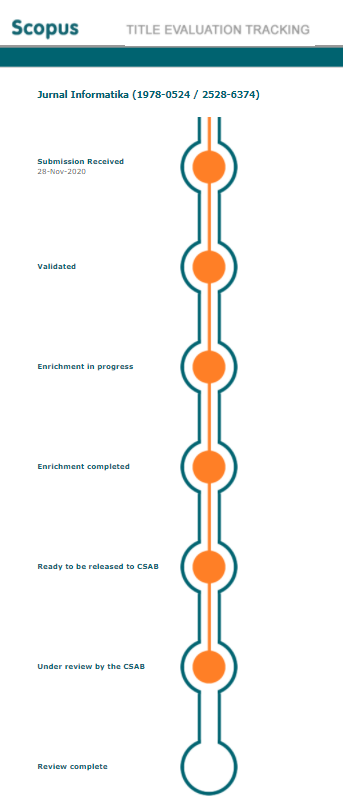Hyper Parameter Tuning of Multilayer Convolutional Network and Augmentation Method for Classification Motive of Batik
Abstract
Full Text:
PDFReferences
Y. M. K. Syabana and G. B. Park, “A study on the applicability of batik for public transportation design in Indonesia,” J. Mechatronics, Electr. Power, Veh. Technol., vol. 11, no. 2, pp. 75–85, Dec. 2020, doi: 10.14203/j.mev.2020.v11.75-85.
K. Nuringsih, C. Cokki, M. N. Nuryasman, and H. Mularsih, “Behind the Pattern: Maintaining the Sustainability of Local Cultural Wisdom in Batik Entrepreneurial Sector,” in Proceedings of the Ninth International Conference on Entrepreneurship and Business Management (ICEBM 2020), May 2021, vol. 174, pp. 1–9, doi: 10.2991/aebmr.k.210507.001.
S. Albawi, T. A. Mohammed, and S. Al-Zawi, “Understanding of a convolutional neural network,” in 2017 International Conference on Engineering and Technology (ICET), Aug. 2017, vol. 2018-Janua, pp. 1–6, doi: 10.1109/ICEngTechnol.2017.8308186.
J. Gu et al., “Recent advances in convolutional neural networks,” Pattern Recognit., vol. 77, pp. 354–377, May 2018, doi: 10.1016/j.patcog.2017.10.013.
A. Mikolajczyk and M. Grochowski, “Data augmentation for improving deep learning in image classification problem,” in 2018 International Interdisciplinary PhD Workshop (IIPhDW), May 2018, pp. 117–122, doi: 10.1109/IIPHDW.2018.8388338.
C. Shorten and T. M. Khoshgoftaar, “A survey on Image Data Augmentation for Deep Learning,” J. Big Data, vol. 6, no. 1, p. 60, Dec. 2019, doi: 10.1186/s40537-019-0197-0.
A. H. Rangkuti, “Classification of Batik Motifs Based on Character Resemblance to Wavelet Transform and Fuzzy Neural Networks,” ComTech Comput. Math. Eng. Appl., vol. 5, no. 1, p. 361, Jun. 2014, doi: 10.21512/comtech.v5i1.2630.
T. Bariyah, M. A. Rasyidi, and N. Ngatini, “Convolutional Neural Network for Multi-Label Classification Method on Batik Motifs,” Techno.Com, vol. 20, no. 1, pp. 155–165, Feb. 2021, doi: 10.33633/tc.v20i1.4224.
D. Hirahara, E. Takaya, T. Takahara, and T. Ueda, “Effects of data count and image scaling on Deep Learning training,” PeerJ Comput. Sci., vol. 6, p. e312, Nov. 2020, doi: 10.7717/peerj-cs.312.
J. G. A. Barbedo, “Impact of dataset size and variety on the effectiveness of deep learning and transfer learning for plant disease classification,” Comput. Electron. Agric., vol. 153, pp. 46–53, Oct. 2018, doi: 10.1016/j.compag.2018.08.013.
Y. Xu and R. Goodacre, “On Splitting Training and Validation Set: A Comparative Study of Cross-Validation, Bootstrap and Systematic Sampling for Estimating the Generalization Performance of Supervised Learning,” J. Anal. Test., vol. 2, no. 3, pp. 249–262, Jul. 2018, doi: 10.1007/s41664-018-0068-2.
B. Vrigazova, “The Proportion for Splitting Data into Training and Test Set for the Bootstrap in Classification Problems,” Bus. Syst. Res. J., vol. 12, no. 1, pp. 228–242, May 2021, doi: 10.2478/bsrj-2021-0015.
K. Simonyan and A. Zisserman, “Very Deep Convolutional Networks for Large-Scale Image Recognition,” in 3rd International Conference on Learning Representations, ICLR 2015 - Conference Track Proceedings, Sep. 2014, pp. 1–14. [Online]. Available at: https://arxiv.org/abs/1409.1556v6.
S. Tammina, “Transfer learning using VGG-16 with Deep Convolutional Neural Network for Classifying Images,” Int. J. Sci. Res. Publ., vol. 9, no. 10, p. p9420, Oct. 2019, doi: 10.29322/IJSRP.9.10.2019.p9420.
M. Ahmed, R. Seraj, and S. M. S. Islam, “The k-means Algorithm: A Comprehensive Survey and Performance Evaluation,” Electronics, vol. 9, no. 8, p. 1295, Aug. 2020, doi: 10.3390/electronics9081295.
E. L. Lydia, S. Kannan, S. SumanRajest, and S. Satyanarayana, “Correlative study and analysis for hidden patterns in text analytics unstructured data using supervised and unsupervised learning techniques,” Int. J. Cloud Comput., vol. 9, no. 2/3, p. 150, 2020, doi: 10.1504/IJCC.2020.109373.
K. Peng, V. C. M. Leung, and Q. Huang, “Clustering Approach Based on Mini Batch Kmeans for Intrusion Detection System Over Big Data,” IEEE Access, vol. 6, pp. 11897–11906, Feb. 2018, doi: 10.1109/ACCESS.2018.2810267.
A. Salma, “Implementation of Multilayer Perceptron for Image Classification,” Proceeding Int. Conf. Sci. Eng., vol. 4, pp. 212–215, Feb. 2021, Accessed: Aug. 01, 2021. [Online]. Available: https://sunankalijaga.org/prosiding/index.php/icse/article/view/660.
H. H. Chieng, N. Wahid, O. Pauline, and S. R. K. Perla, “Flatten-T Swish: a thresholded ReLU-Swish-like activation function for deep learning,” Int. J. Adv. Intell. Informatics, vol. 4, no. 2, p. 76, Jul. 2018, doi: 10.26555/ijain.v4i2.249.
N. D. Miranda, L. Novamizanti, and S. Rizal, “Convolutional Neural Network Pada Klasifikasi Sidik Jari Menggunakan Resnet-50,” J. Tek. Inform., vol. 1, no. 2, pp. 61–68, Dec. 2020, doi: 10.20884/1.jutif.2020.1.2.18.
J. Yang and G. Yang, “Modified Convolutional Neural Network Based on Dropout and the Stochastic Gradient Descent Optimizer,” Algorithms, vol. 11, no. 3, p. 28, Mar. 2018, doi: 10.3390/a11030028.
R. Sweke et al., “Stochastic gradient descent for hybrid quantum-classical optimization,” Quantum, vol. 4, p. 314, Aug. 2020, doi: 10.22331/q-2020-08-31-314.
DOI: http://dx.doi.org/10.26555/jifo.v17i1.a25823
Refbacks
- There are currently no refbacks.
Copyright (c) 2023 Agus Nursikuwagus, tono hartono, M A Nurwicaksono, M M Choir, M A Saputri

This work is licensed under a Creative Commons Attribution-ShareAlike 4.0 International License.
____________________________________
JURNAL INFORMATIKA
ISSN :Â 1978-0524 (print) | 2528-6374 (online)

This work is licensed under a Creative Commons Attribution-ShareAlike 4.0 International License.






